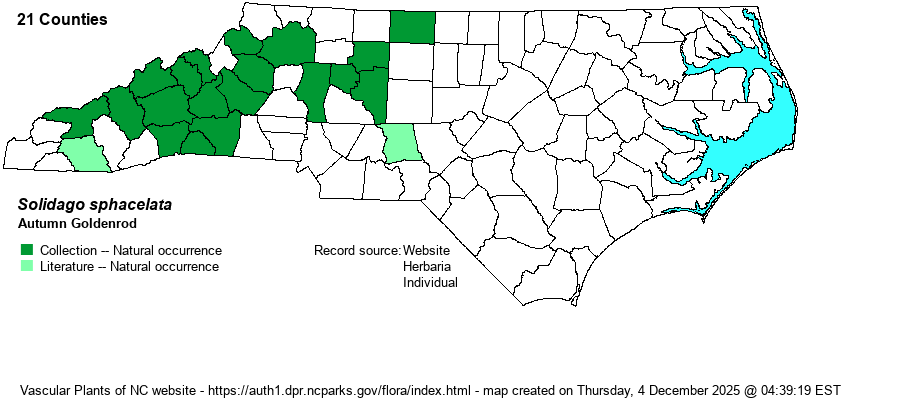| Author | Rafinesque | |
| Distribution | Mountains and western half of the Piedmont, ranging east to Rockingham and Montgomery counties.
Central VA to southern IL, south to GA and MS. | |
| Abundance | Uncommon to infrequent, and rather local, in the Mountains. Rare and local in the western half of the Piedmont. The species is localized owing to its requirement for calcareous or mafic rocks in shady or partly-shady forests. | |
| Habitat | Dry semi-open to shaded rocky slopes, cliffs, montane glades, outcrops; rocks must be mafic to calcareous. It tends to occur at somewhat shaded outcrops, as opposed to exposed and sunny places. | |
| Phenology | Flowering and fruiting late July-September. | |
| Identification | This is a distinctive species that should be easily identified: the basal leaves are widely ovate and with distinctly cordate (heart-shaped notch) bases, toothed margins, and slender stalks. Stem leaves are progressively smaller, their bases mostly rounded. The inflorescence is composed of spreading, curved branches and also a terminal spike. Each flowering branch is spike-like with flowers on all sides of the branch. Plants grow 2-3 feet tall and often just as wide or wider, with stems covered with short hairs. It is unfortunate that this is such an uncommon plant in NC, as it is so distinctive in its heart-shaped basal leaves and "spiky" flower clusters on leaning and often downcurved branches, growing in soil patches on rocky slopes. | |
| Taxonomic Comments | It occurs in its own Section of the genus, and is so distinct that for a while it was put into its own genus -- Brachychaeta cordata.
| |
| Other Common Name(s) | Heartleaf Goldenrod, Golden-fleece Goldenrod, Limestone Goldenrod, False Goldenrod. Autumn Goldenrod is a poor common name, as nearly all goldenrods bloom in the fall; this is no different in timing than others. But this is, by far, the most often used common name. It is hoped that a more descriptive name, such as Heartleaf Goldenrod, or False Goldenrod, as a very few websites use, can gain more usage. | |
| State Rank | S3? [S3] | |
| Global Rank | G4G5 | |
| State Status | | |
| US Status | | |
| USACE-agcp | | |
| USACE-emp | | |

